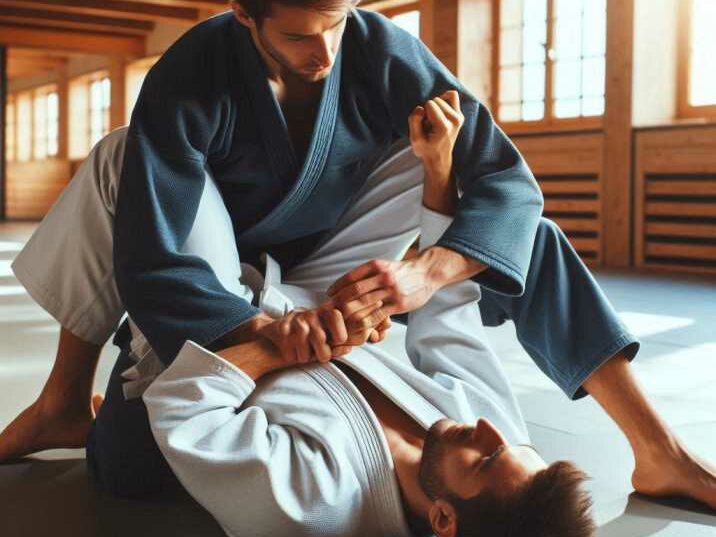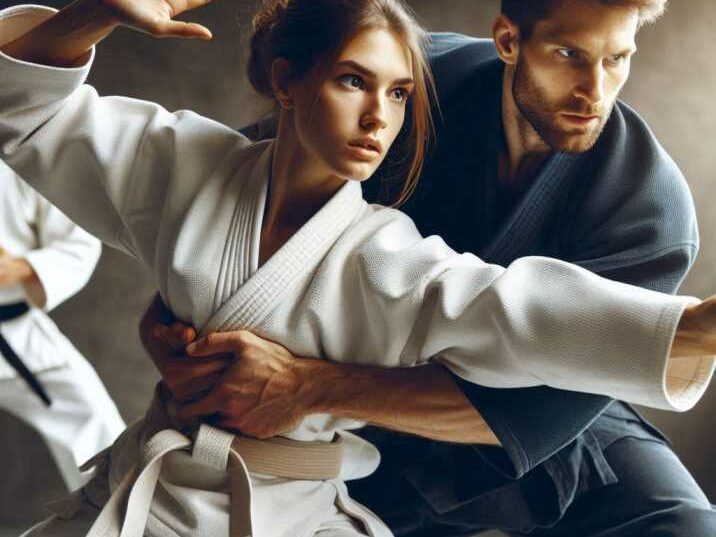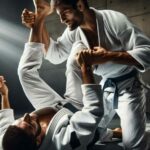Introduction
Table of Contents
Welcome to the fascinating world of Aiki Jujutsu, an ancient martial art combining energy redirection, joint manipulation, and strategic control. Whether you’re a seasoned martial artist seeking to expand your repertoire or a newcomer intrigued by the allure of traditional Japanese combat techniques, this comprehensive guide is for you.In this blog post, we will delve into the rich history of Aiki Jujutsu, explore its core techniques, and provide practical insights to help you master this art. Expect to uncover the secrets behind its effectiveness, learn about key training methods, and find out how Aiki Jujutsu techniques can enhance your physical and mental well-being.

The Origins and Evolution of Aiki Jujutsu
The Birth of Aiki Jujutsu
Aiki Jujutsu traces its roots back to feudal Japan, a time when samurai warriors relied on effective hand-to-hand combat techniques for survival on the battlefield. The term “Aiki” refers to the harmonious blending of energy, while “Jujutsu” denotes the art of flexibility or yielding. Together, Aiki Jujutsu signifies a martial art that emphasizes the harmonious use of an opponent’s energy to neutralize attacks.
Key Historical Figures
- Takeda Sokaku (1859-1943): Often regarded as the modern father of Aiki Jujutsu, Takeda Sokaku is credited with systematizing and popularizing the art. His teachings influenced many subsequent martial arts, including Aikido.
- Morihei Ueshiba (1883-1969): A direct student of Takeda Sokaku, Ueshiba went on to develop Aikido, incorporating many principles of Aiki Jujutsu while emphasizing spiritual and philosophical aspects.
Evolution and Modern Practice
Aiki Jujutsu has evolved over centuries, adapting to changing societal needs while retaining its core principles. Today, it is practiced worldwide, both as a traditional martial art and as a means of personal development and self-defense.
Core Principles of Aiki Jujutsu
Aiki: The Harmony of Energy
At the heart of Aiki Jujutsu lies the concept of Aiki, the blending and redirection of an opponent’s energy. Practitioners learn to sense and manipulate the force of an attack, using minimal effort to achieve maximum effect.
Jujutsu: Flexibility and Yielding
Jujutsu emphasizes flexibility, leverage, and the strategic use of an opponent’s momentum. Techniques often involve joint locks, throws, and pins, allowing a practitioner to control and neutralize an aggressor without relying on brute strength.
Timing and Distance
Mastery of timing (maai) and distance (ma) is crucial in Aiki Jujutsu. Practitioners train to anticipate and evade attacks, positioning themselves advantageously to apply techniques effectively.
Essential Aiki Jujutsu Techniques
Joint Locks (Kansetsu Waza)
Joint locks are fundamental to Aiki Jujutsu Techniques, targeting the wrists, elbows, shoulders, and other joints to immobilize or control an opponent. Key techniques include:
- Nikyo (Second Control): A wrist lock that applies pressure to the tendons and nerves, causing pain and compliance.
- Sankyo (Third Control): A rotational wrist lock that disrupts an opponent’s balance and control.
Throws (Nage Waza)
Throws in Aiki Jujutsu leverage an opponent’s momentum to execute powerful and efficient takedowns. Notable throws include:
- Irimi Nage (Entering Throw): A technique that involves moving directly into the opponent’s space to unbalance and throw them.
- Kote Gaeshi (Wrist Twist Throw): A throw that utilizes a twisting motion on the wrist to project the opponent.

Strikes (Atemi Waza)
While Aiki Jujutsu techniques primarily focuses on joint locks and throws, strikes (atemi) play a vital role in setting up techniques and disrupting an opponent’s attacks. Common strikes include:
- Shomen Uchi (Front Strike): A downward strike aimed at the head or face.
- Tsuki (Thrust): A straight punch or thrust targeting the torso.
Pins (Osae Waza)
Pins secure an opponent to the ground, neutralizing their ability to continue fighting. Effective pins include:
- Yokomen Uchi (Side Pin): A pin that controls the opponent’s head and upper body.
- Kata Gatame (Shoulder Hold): A pin that immobilizes the opponent’s shoulder and arm.
Defense Against Grabs and Holds
Aiki Jujutsu techniques are designed to counter various grabs and holds, utilizing principles of leverage and energy redirection. Examples include:
- Gyaku Hanmi Katate Dori (Reverse Stance Wrist Grab): Techniques to escape and counter a wrist grab from a reverse stance.
- Morote Dori (Two-Hand Grab): Methods to break free from a two-hand grab and gain control.
Training Methods and Drills
Kata: Form Practice
Kata, or pre-arranged forms, are essential for internalizing Aiki Jujutsu techniques and principles. Practitioners perform sequences of movements with precision, focusing on correct posture, timing, and execution.
Randori: Free Practice
Randori, or free practice, allows practitioners to apply techniques in a dynamic and unpredictable environment. This form of training fosters adaptability and spontaneity, honing the ability to respond to real-world situations.
Ukemi: The Art of Falling
Ukemi, or breakfall training, is crucial in Aiki Jujutsu. Practitioners learn to fall safely and efficiently, minimizing the risk of injury during throws and takedowns. Key ukemi techniques include:
- Mae Ukemi (Forward Roll): A roll that disperses impact and allows for a quick recovery.
- Ushiro Ukemi (Backward Breakfall): A backward fall that protects the head and spine.
Conditioning and Strength Training
Physical conditioning is vital for Aiki Jujutsu practitioners. Strength training, flexibility exercises, and cardiovascular workouts enhance overall fitness and improve performance in techniques.
The Benefits of Practicing Aiki Jujutsu
Physical Fitness
Aiki Jujutsu provides a full-body workout, improving strength, flexibility, and endurance. Regular practice enhances cardiovascular health and promotes overall well-being.
Mental Discipline
The mental aspects of Aiki Jujutsu, such as focus, concentration, and strategic thinking, foster mental discipline and resilience. Practitioners develop a heightened sense of awareness and the ability to remain calm under pressure.
Self-Defense Skills
Aiki Jujutsu equips practitioners with effective self-defense skills, enabling them to protect themselves and others in various situations. The emphasis on leverage and technique makes it accessible to individuals of all sizes and strengths.
Personal Development
The practice of Aiki Jujutsu promotes personal growth and self-discovery. The principles of harmony, balance, and adaptability extend beyond the dojo, enhancing one’s approach to everyday life.
Conclusion
Aiki Jujutsu is a timeless martial art that offers a wealth of physical, mental, and personal benefits. By mastering its techniques and principles, practitioners gain not only practical self-defense skills but also enhanced physical fitness and mental discipline. Whether you’re drawn to its historical roots or its modern applications, Aiki Jujutsu promises a rewarding journey of discovery and growth.
FAQs About Aiki Jujutsu
- What is the difference between Aiki Jujutsu and Aikido?
- Aiki Jujutsu focuses more on practical self-defense techniques, including joint locks and throws, while Aikido emphasizes spiritual and philosophical aspects, promoting harmony and non-violence.
- Is Aiki Jujutsu suitable for beginners?
- Yes, Aiki Jujutsu is accessible to practitioners of all levels. Beginners can start with basic techniques and gradually progress to more advanced training.
- Do I need to be physically strong to practice Aiki Jujutsu?
- No, Aiki Jujutsu relies on leverage, timing, and technique rather than brute strength, making it suitable for individuals of all physical abilities.
- How long does it take to become proficient in Aiki Jujutsu?
- Proficiency in Aiki Jujutsu varies depending on individual dedication and practice frequency. Consistent training over several years is typically required to achieve a high level of skill.
- Can Aiki Jujutsu be used for self-defense?
- Yes, Aiki Jujutsu is highly effective for self-defense, teaching techniques to neutralize and control aggressors in various scenarios.


